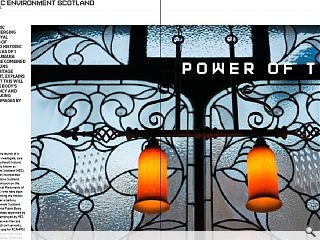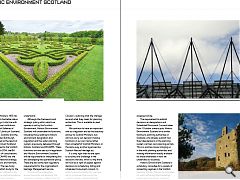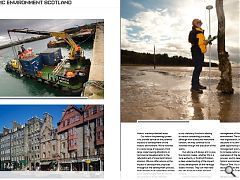HES: Power of Two
19 Oct 2015
With Historic Scotland merging with the Royal Commission of Ancient and Historic Monuments as of 1 October Barbara Cummins, the combined organisations head of heritage management, explains what effect this will have on the body’s transparency and decision making processes. Images by HES.
October 2015 saw the launch of a new public body to investigate, care for and promote Scotland’s historic environment. Legally known as Historic Environment Scotland (HES), the new organisation incorporates the strengths of Historic Scotland and the Royal Commission on the Ancient and Historical Monuments of Scotland (RCAHMS) who have been managing and recording the historic environment for over a century.Historic Environment Scotland is a Non Departmental Public Body with a Board of Trustees appointed by Ministers. Staff are employed by HES and are no longer (as was the case for Historic Scotland) civil servants, but are (as was the case for RCAHMS) public servants. This provides some operating independence, combined with transparency and public facing accountability as well as formal accountability to Ministers. HES has also been awarded charitable status, and all of this brings it into line with other national cultural institutions such as the National Galleries of Scotland, National Library of Scotland, National Museums Scotland and the Royal Botanic Garden Edinburgh.
HES was formed as the result of the Historic Environment Scotland Act 2014. Introduced to the Scottish Parliament in March 2014, the Bill followed a number of consultations on the future of RCAHMS and the development of a national strategy for Scotland’s historic environment, Our Place in Time. The new body will be the lead Scottish body for the historic environment, defined in Our Place in Time as ‘the physical evidence for human activity that connects people with place, linked with the associations we can see, feel and understand.’
Although the framework and strategic policy within which we operate is set by the Scottish Government, Historic Environment Scotland will undertake the functions, including those relating to historic environment designation and regulation and the wider planning system, previously delivered through Historic Scotland and RCAHMS. These functions are now set out in legislation and Historic Environment Scotland will be responsible for interpreting this and developing the operational policy. There are also some new regulatory requirements for the organisation’s Heritage Management service.
To ensure that colleagues across the sector are aware of the regulatory changes in effect from 1st October, Historic Scotland compiled the Historic Environment Scotland Circular 1, outlining what the changes are and what they mean for planning authorities. This is available to read online.
We continue to have an important role as a regulator and as the statutory adviser to Scottish Ministers, but will now carry out decision-making functions in our own name rather than on behalf of Scottish Ministers, in the same way as other agencies like Scottish Natural Heritage do.
It is only right that we are open to scrutiny and challenge in the decisions we take, which is why there will now be a right of appeal against decisions on scheduling, listing and scheduled monument consent. In order to accommodate this, we have set up processes that mirror the systems already well-established in the planning system, such as a new planning portal which can be accessed online.
The requirement to publish decisions on designations and Scheduled Monument Consent taken from 1 October onward puts Historic Environment Scotland on a similar footing to planning authorities in Scotland, who already publish how they take decisions in the planning system via their own planning portals. This is a positive move, bringing us in line with planning authorities and making information readily available for those interested in how we undertake our business.
Historic Environment Scotland is a statutory consultee for a variety of consenting regimes in the Scottish planning system. We can be consulted on works affecting listed buildings, scheduled monuments, inventory battlefields, gardens and designed landscapes, World Heritage Sites and historic marine protected areas.
Our role in the planning system is to provide advice on the potential impacts of development on the historic environment. We’re involved in a wide range of casework, from large-scale housing allocations or commercial developments to the refurbishment of important historic interiors. We can offer advice on the impact of development proposals throughout the development process, from advising local authorities on their Local Development Plan allocations and policies to being statutory consultees on a planning application. The advice we give is often linked to our statutory functions relating to various consenting processes, although with scheduled monument consent, we may continue to be involved through the execution of the works.
Our advice will always aim to give the decision maker, whether this is a local authority or Scottish Ministers, a clear understanding of the impact of any development on the heritage assets involved. They can then take this into account in their decision making.
Overall, Historic Environment Scotland will be more transparent in what we do to support the management of the country’s historic environment. The structure of the new organisation, able to make decisions in its own name, gives us a great opportunity to develop heritage management policy collaboratively, to increase public understanding and awareness of the decision making process, and to take forward the historic environment strategy, Our Place in Time. As a result, we will be accountable to and deliver a better service for the Scottish people.
Barbara Cummins, Director of Heritage Management
Historic Environment Scotland
|
|
Read next: Manuel Brickworks
Read previous: Retirement accommodation: Grey Area
Back to October 2015
Browse Features Archive
Search
News
For more news from the industry visit our News section.
Features & Reports
For more information from the industry visit our Features & Reports section.





